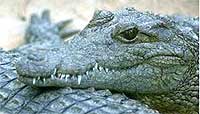 | Alligators Detect Water Movement with Special Sensory Receptors |
 | Alligators Detect Water Movement with Special Sensory Receptors |
|
August 8, 2002
Although our senses are well suited to our environment, many animals are equipped with sensory systems that we lack. For example, rattlesnakes have a sensitive organ between their eyes and nostrils to detect heat. Penguins can see into the ultraviolet range. Alligators have special sensory receptors to detect ripples in the water, according to new work done by Daphne Soares, a graduate student in the Department of Biology at the University of Maryland.
Soares believes that these special sensory receptors, which she calls dome pressure receptors (DPRs), are used by crocodilians to hunt, especially at night. Small disturbances on the water, such as that caused by a bird or frog, may trigger the DPRs and help the alligator catch its next meal.
|
|
References and further information:
|
| GO TO: | Neuroscience In The News | Explore the Nervous System | Table of Contents |
![[email]](./gif/menue.gif) Send E-mail |
 Fill out survey |
 Get Newsletter |
 Search Pages |
 Take Notes |